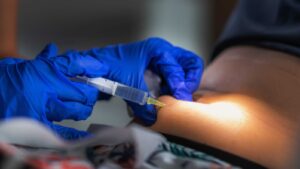Introduction
Liposuction is a popular cosmetic procedure that can help you get rid of stubborn fat deposits in certain areas of your body. It’s used to contour the body and eliminate cellulite, giving patients a slimmer, more toned look. In this blog post, we’ll discuss the safety considerations associated with liposuction and what you should know before deciding if it’s right for you.
Keep reading to learn more.
What is Liposuction and What Does it Treat?

Liposuction is a surgical procedure used to remove fat deposits from specific areas of the body. Commonly referred to as lipo, it’s used to contour and shape the body by removing localized pockets of excess fat. It’s most commonly performed on the abdomen, hips, buttocks, thighs, knees, chin, upper arms and chest, and it can be used to treat mild to moderate skin laxity.
Liposuction is not a weight-loss procedure and should only be considered if you are close to your ideal body weight and have localized deposits of fat that diet and exercise alone can’t remove. It’s important to discuss your expectations with a qualified provider such as the Lumen Center before undergoing this procedure.
How Does Liposuction Work?
During liposuction, the administrator inserts a thin tube called a cannula through small incisions in the skin. The cannula is connected to a powerful suction device that vacuums fat cells out of the body. In some cases, the administrator may also use ultrasonic energy to help break down fat cells before they are removed.
The amount of fat removed during liposuction can vary from person to person. Some patients only require a small amount of fat to be removed, while others may need larger amounts taken out. Your provider will work with you to determine the best amount of fat to be removed for your body type.
Liposuction Side Effects and Risks
The most common risks associated with liposuction are infection, scarring, and blood clots. The procedure can also cause temporary numbness or bruising around the treated area as well as damage to underlying organs such as the intestines, bladder, and rectum. In rare cases, liposuction may lead to permanent nerve damage.
Another important risk to consider is fat embolism syndrome (FES). FES is a potentially dangerous condition in which fat enters the bloodstream and is carried to other organs, such as the lungs, brain, or heart. Symptoms of FES include fever, confusion, shortness of breath, chest pain, and an irregular heartbeat.
Before undergoing liposuction, it’s important for people to weigh the potential risks with the potential benefits of the procedure. Patients should discuss their concerns with their provider and ensure they are informed of all potential complications. It’s also important to follow any pre- and post-operative instructions provided by your administrator in order to minimize the risks associated with liposuction.
Liposuction Safety Measures
To ensure the highest standards of safety for patients undergoing liposuction, providers take certain precautions before, during, and after the procedure.
Prior to the Procedure: Patients should always consult a board-certified plastic surgeon prior to undergoing liposuction. During the consultation, patients should discuss their goals, expectations, and any medical conditions they may have that could affect the safety of the procedure. The provider will also evaluate each patient’s anatomy before determining if liposuction is an appropriate treatment for them.
During the Procedure: Anesthesia is typically used during liposuction to mitigate any potential discomfort from the procedure. The type and amount of anesthesia used will depend on a number of factors, such as the patient’s medical history and the complexity of the surgery. During this time, the administrator will monitor vital signs closely to ensure that the patient stays safe and comfortable.
After the Procedure: After liposuction, patients may need to wear a compression garment for some time to reduce swelling and accelerate healing. The provider will also provide instructions about activities that should be avoided during the recovery period, such as strenuous exercise or stretching. It’s important for patients to follow these instructions in order to ensure their safety and optimize their results.
Conclusion
In conclusion, liposuction is a safe and effective procedure for those looking to reduce fat in specific areas of their body. While there are risks associated with any type of surgery, these can be minimized by working closely with your provider to ensure you have the safest possible experience. Liposuction may not be suitable for everyone, but it can provide great results if executed carefully and deliberately.






